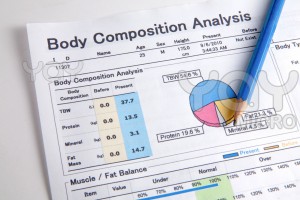Body Composition Assessment and Analysis
Body composition refers to the percentage of fat, bone, and muscle in the human body. Having an unhealthy body composition, either caused by too high or too low of body fat, can increase one’s health risks and cause complications. There are a number of different methods that can aid in measuring body composition. An individuals’ BMI or Body Mass Index is a very generalized way of indicating a persons weight class. It is based on the individuals’ height and weight, which determines whether the individual is underweight (<18.5), normal (18.5-25), overweight (25-30) or obese (>30). This measure is very basic and unreliable in that it doesn’t take into account if the weight comes from muscle or fat, and where that fat is located on the body. All of these basic measures taken together give us a good starting point to initiate a fitness regimen.
Waist Circumference sizes are also seen as a very valuable measure, and are taken in centimeters around an individuals midline region. This measure can provide an indication of health risk dependent on the diameter of the measure.
CPFLA Skinfold Sites are often viewed as an invasive technique, and it takes skinfolds at 5 different body sites to produce a SO5S which is the sum of the 5 skin folds.
Using all three assessments will generate a much more accurate health indication. To get these tests completed for each individual an additional 40$ will be added to the session. Using these results will help the trainer see where the client is at health-wise, and how much they need to improve as well as how they will improve each individual.
